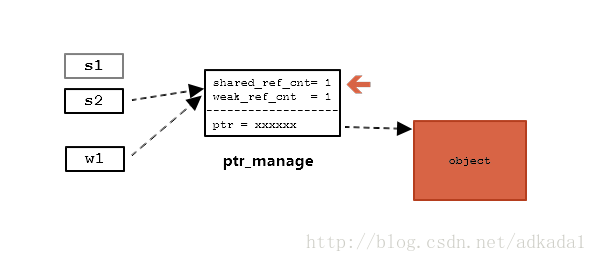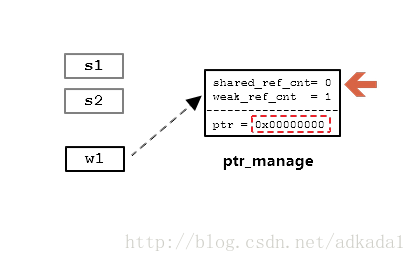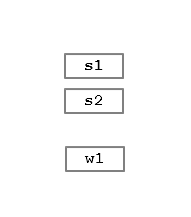C++11中的智能指针
转载:https://my.oschina.net/hevakelcj/blog/465978
在C++11中,引入了智能指针。主要有:unique_ptr, shared_ptr, weak_ptr。
这3种指针组件就是采用了boost里的智能指针方案。很多有用过boost智能指针的朋友,很容易地就能发现它们之间的关间:
| std | boost | 功能说明 |
|---|---|---|
| unique_ptr | scoped_ptr | 独占指针对象,并保证指针所指对象生命周期与其一致 |
| shared_ptr | shared_ptr | 可共享指针对象,可以赋值给shared_ptr或weak_ptr。指针所指对象在所有的相关联的shared_ptr生命周期结束时结束,是强引用。 |
| weak_ptr | weak_ptr | 它不能决定所指对象的生命周期,引用所指对象时,需要lock()成shared_ptr才能使用。 |
C++11将boost里的这一套纳入了标准。
如下为示例代码:
//文件 test-1.cpp
#include // 编译命令: g++ -std=c++11 test-1.cpp
[1]: unique_ptr 是禁止复制赋值的,始终保持一个 unique_ptr 管理一个对象。
[2]: unique_ptr 虽然不能赋值,但可以通过 move() 函数转移对象的所有权。一旦被 move() 了,原来的 up1 则不再有效了。
[3]: reset() 可以让 unique_ptr 提前释放指针。
[4]: 由 shared_ptr 构造一个 weak_ptr。
注意:
1、如何创建unique_ptr
unique_ptr不像shared_ptr一样拥有标准库函数make_shared来创建一个shared_ptr实例。要想创建一个unique_ptr,我们需要将一个new 操作符返回的指针传递给unique_ptr的构造函数。
int main()
{
// 创建一个unique_ptr实例
unique_ptr<int> pInt(new int(5));
cout << *pInt;
}2、无法进行复制构造和赋值操作
int main()
{
// 创建一个unique_ptr实例
unique_ptr<int> pInt(new int(5));
unique_ptr<int> pInt2(pInt); // 报错
unique_ptr<int> pInt3 = pInt; // 报错
}3、可以进行移动构造和移动赋值操作
int main()
{
unique_ptr<int> pInt(new int(5));
unique_ptr<int> pInt2 = std::move(pInt); // 转移所有权
//cout << *pInt << endl; // 出错,pInt为空
cout << *pInt2 << endl;
unique_ptr<int> pInt3(std::move(pInt2));
}4、可以返回unique_ptr
unique_ptr<int> clone(int p)
{
unique_ptr<int> pInt(new int(p));
return pInt; // 返回unique_ptr
}
int main() {
int p = 5;
unique_ptr<int> ret = clone(p);
cout << *ret << endl;
}unique_ptr使用场景:
1、为动态申请的资源提供异常安全保证
void Func()
{
int *p = new int(5);
// ...(可能会抛出异常)
delete p;
}2、返回函数内动态申请资源的所有权
unique_ptr<int> Func(int p)
{
unique_ptr<int> pInt(new int(p));
return pInt; // 返回unique_ptr
}
int main() {
int p = 5;
unique_ptr<int> ret = Func(p);
cout << *ret << endl;
// 函数结束后,自动释放资源
}3、在容器中保存指针
int main()
{
vectorint >> vec;
unique_ptr<int> p(new int(5));
vec.push_back(std::move(p)); // 使用移动语义
}4、管理动态数组
int main()
{
unique_ptr<int[]> p(new int[5] {1, 2, 3, 4, 5});
p[0] = 0; // 重载了operator[]
}shared_ptr 与 weak_ptr
如下面的示例:
shared_ptr<string> s1(new string);
shared_ptr<string> s2 = s1;
weak_ptr<string> w1 = s2;在内存中:

s1, s2, w1 都指向一个 ptr_manage 的对象。
在该对象中有 shared_ref_count 与 weak_ref_count 两个域分别记录引用它的 shared_ptr 与 weak_ptr 的个数。这个很容易办到,只要在复制构造与赋值函数中对相当地引用值进行加1,在析构中减1即可。ptr_manage 中的 ptr 域存放真正的对象指针地址。
当 shared_ref_cnt 被减为0时,自动释放 ptr 指针所指向的对象。当 shared_ref_cnt 与 weak_ref_cnt 都变成0时,才释放 ptr_manage 对象。
如此以来,只要有相关联的 shared_ptr 存在,对象就存在。weak_ptr 不影响对象的生命周期。当用 weak_ptr 访问对象时,对象有可能已被释放了,要先 lock()。
当执行:
s1.reset()
此时:

shared_ref_cnt 由2减成了1。
再执行:
s2.reset()
此时:

shared_ref_cnt 已被减到0了,ptr 所对应的object已被释放,ptr 被清0。此时,ptr_manage 依旧保留。因为 w1 还需要引用它。
在最后,w1 也析构了的时候:

ptr_manage 中的 weak_ref_cnt 被减成0,最后连 ptr_manage 都释放了。